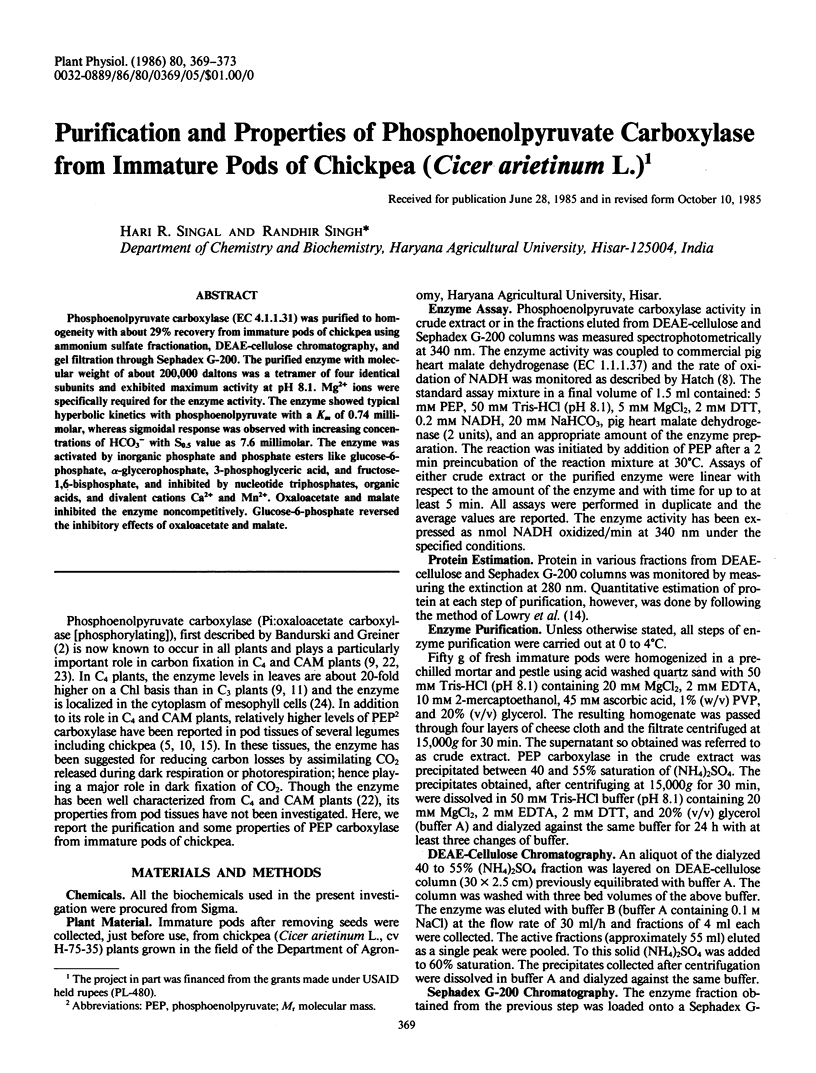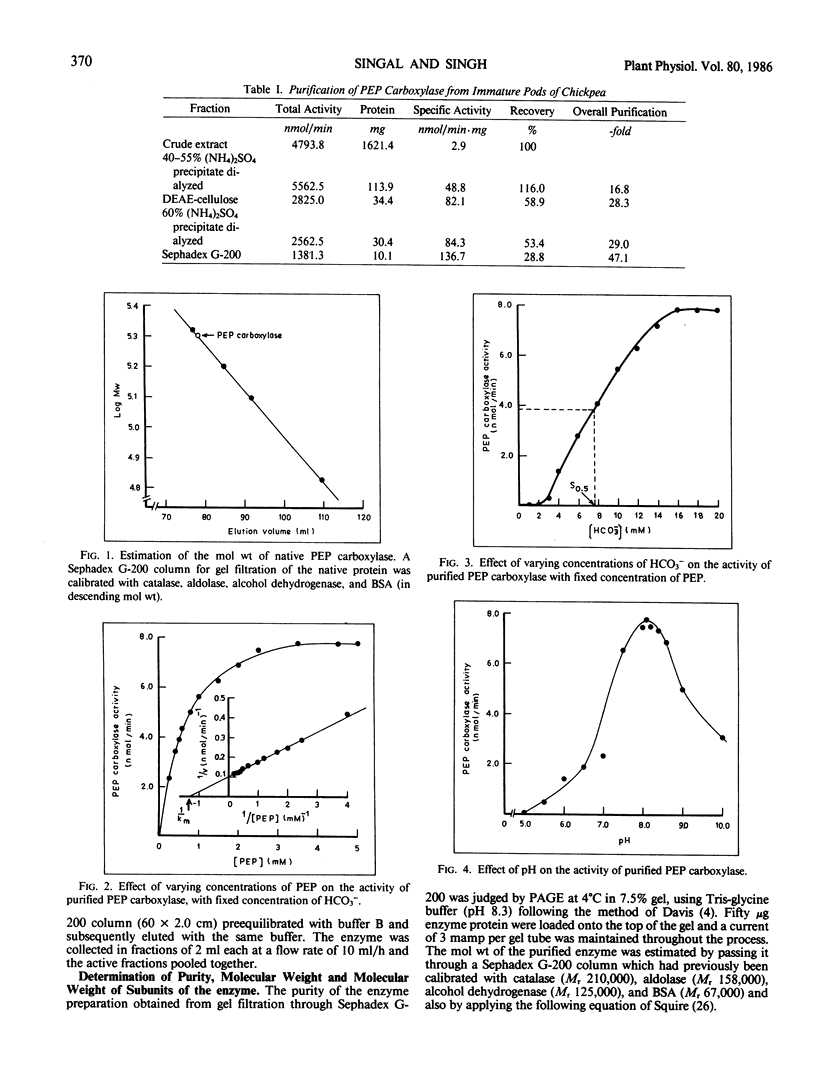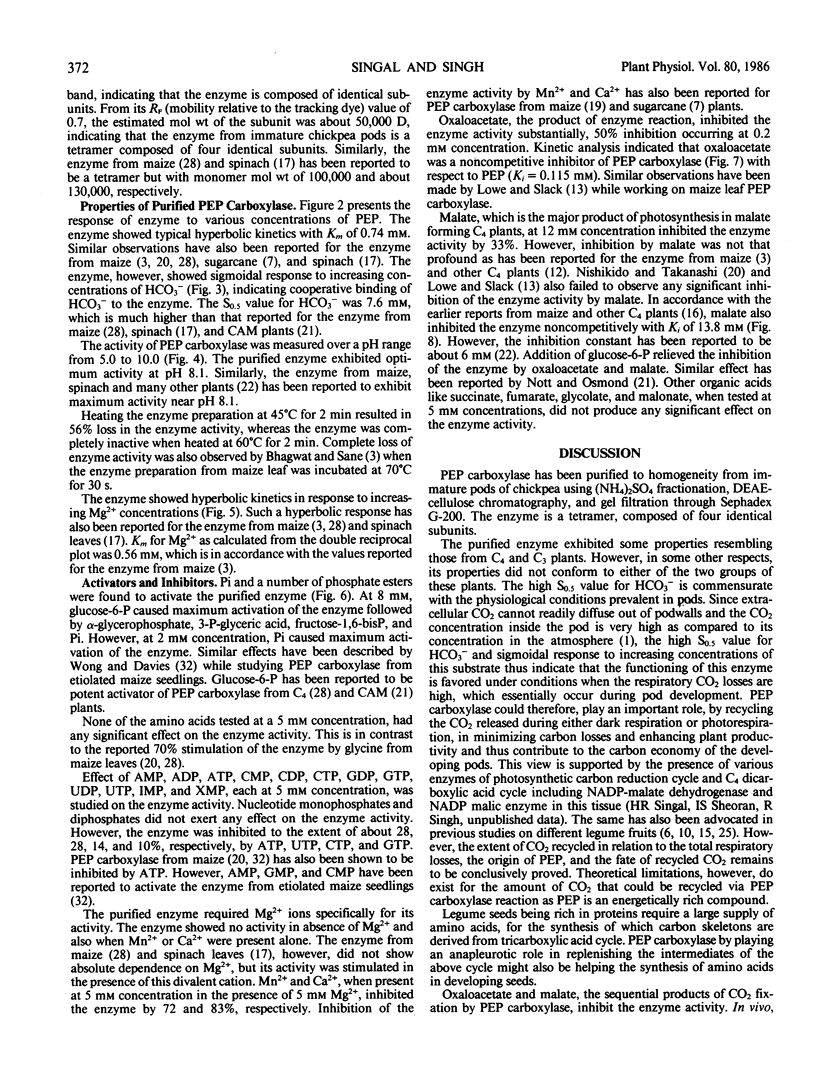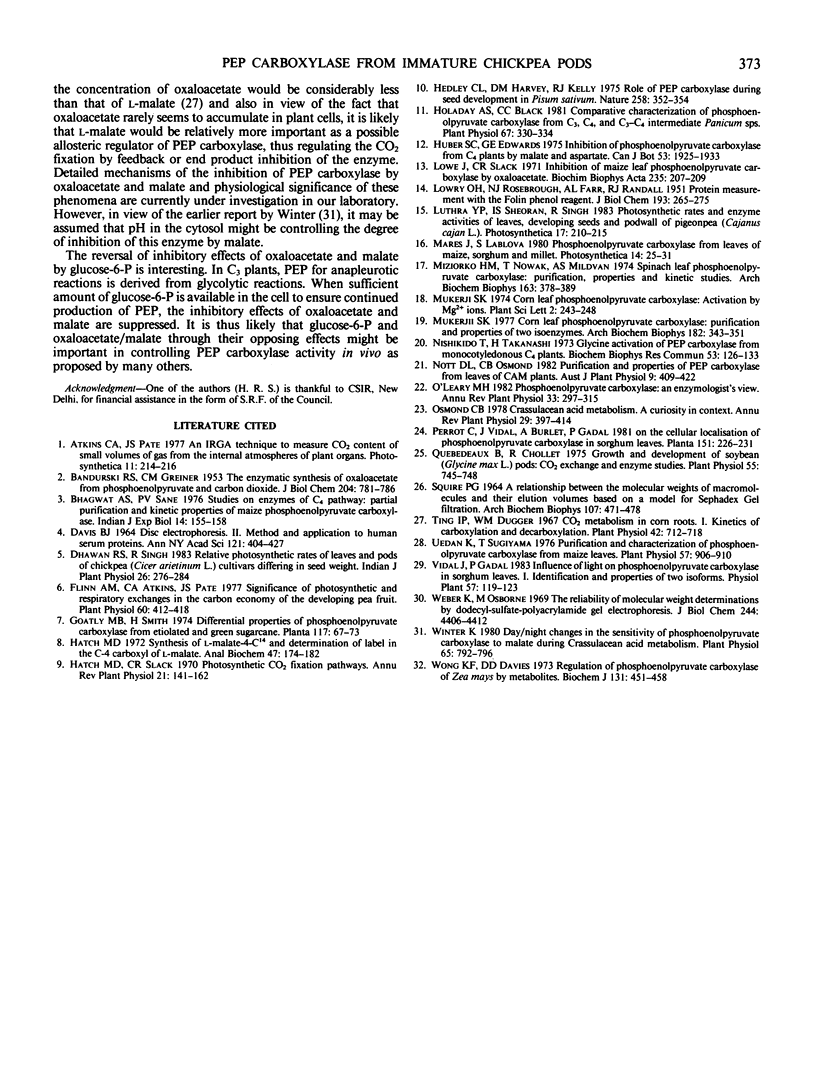Abstract
Phosphoenolpyruvate carboxylase (EC 4.1.1.31) was purified to homogeneity with about 29% recovery from immature pods of chickpea using ammonium sulfate fractionation, DEAE-cellulose chromatography, and gel filtration through Sephadex G-200. The purified enzyme with molecular weight of about 200,000 daltons was a tetramer of four identical subunits and exhibited maximum activity at pH 8.1. Mg2+ ions were specifically required for the enzyme activity. The enzyme showed typical hyperbolic kinetics with phosphoenolpyruvate with a Km of 0.74 millimolar, whereas sigmoidal response was observed with increasing concentrations of HCO3− with S0.5 value as 7.6 millimolar. The enzyme was activated by inorganic phosphate and phosphate esters like glucose-6-phosphate, α-glycerophosphate, 3-phosphoglyceric acid, and fructose-1,6-bisphosphate, and inhibited by nucleotide triphosphates, organic acids, and divalent cations Ca2+ and Mn2+. Oxaloacetate and malate inhibited the enzyme noncompetitively. Glucose-6-phosphate reversed the inhibitory effects of oxaloacetate and malate.
Full text
PDF




Selected References
These references are in PubMed. This may not be the complete list of references from this article.
- BANDURSKI R. S., GREINER C. M. The enzymatic synthesis of oxalacetate from phosphoryl-enolpyruvate and carbon dioxide. J Biol Chem. 1953 Oct;204(2):781–786. [PubMed] [Google Scholar]
- DAVIS B. J. DISC ELECTROPHORESIS. II. METHOD AND APPLICATION TO HUMAN SERUM PROTEINS. Ann N Y Acad Sci. 1964 Dec 28;121:404–427. doi: 10.1111/j.1749-6632.1964.tb14213.x. [DOI] [PubMed] [Google Scholar]
- Flinn A. M., Atkins C. A., Pate J. S. Significance of photosynthetic and respiratory exchanges in the carbon economy of the developing pea fruit. Plant Physiol. 1977 Sep;60(3):412–418. doi: 10.1104/pp.60.3.412. [DOI] [PMC free article] [PubMed] [Google Scholar]
- Hatch M. D. Synthesis of L-malate-4- 14 C and determination of label in the C-4 carboxyl of L-malate. Anal Biochem. 1972 May;47(1):174–183. doi: 10.1016/0003-2697(72)90290-4. [DOI] [PubMed] [Google Scholar]
- Holaday A. S., Black C. C. Comparative characterization of phosphoenolpyruvate carboxylase in c(3), c(4), and c(3)-c(4) intermediate panicum species. Plant Physiol. 1981 Feb;67(2):330–334. doi: 10.1104/pp.67.2.330. [DOI] [PMC free article] [PubMed] [Google Scholar]
- LOWRY O. H., ROSEBROUGH N. J., FARR A. L., RANDALL R. J. Protein measurement with the Folin phenol reagent. J Biol Chem. 1951 Nov;193(1):265–275. [PubMed] [Google Scholar]
- Lowe J., Slack C. R. Inhibition of maize leaf phosphopyruvate carboxylase by oxaloacetate. Biochim Biophys Acta. 1971 Apr 14;235(1):207–209. doi: 10.1016/0005-2744(71)90048-9. [DOI] [PubMed] [Google Scholar]
- Miziorko H. M., Nowak T., Mildvan A. S. Spinach leaf phosphoenolpyruvate carboxylase: purification, properties, and kinetic studies. Arch Biochem Biophys. 1974 Jul;163(1):378–389. doi: 10.1016/0003-9861(74)90489-5. [DOI] [PubMed] [Google Scholar]
- Mukerji S. K. Corn leaf phosphoenolpyruvate carboxylases. Purification and properties of two isoenzymes. Arch Biochem Biophys. 1977 Jul;182(1):343–351. doi: 10.1016/0003-9861(77)90315-0. [DOI] [PubMed] [Google Scholar]
- Nishikido T., Takanashi H. Glycine activation of PEP carboxylase from monocotyledoneous C4 plants. Biochem Biophys Res Commun. 1973 Jul 2;53(1):126–133. doi: 10.1016/0006-291x(73)91410-1. [DOI] [PubMed] [Google Scholar]
- Quebedeaux B., Chollet R. Growth and Development of Soybean (Glycine max [L.] Merr.) Pods: CO(2) Exchange and Enzyme Studies. Plant Physiol. 1975 Apr;55(4):745–748. doi: 10.1104/pp.55.4.745. [DOI] [PMC free article] [PubMed] [Google Scholar]
- SQUIRE P. G. A RELATIONSHIP BETWEEN THE MOLECULAR WEIGHTS OF MACROMOLECULES AND THEIR ELUTION VOLUMES BASED ON A MODEL FOR SEPHADEX GEL FILTRATION. Arch Biochem Biophys. 1964 Sep;107:471–478. doi: 10.1016/0003-9861(64)90303-0. [DOI] [PubMed] [Google Scholar]
- Ting I. P., Dugger W. M. CO(2) Metabolism in Corn Roots. I. Kinetics of Carboxylation and Decarboxylation. Plant Physiol. 1967 May;42(5):712–718. doi: 10.1104/pp.42.5.712. [DOI] [PMC free article] [PubMed] [Google Scholar]
- Uedan K., Sugiyama T. Purification and characterization of phosphoenolpyruvate carboxylase from maize leaves. Plant Physiol. 1976 Jun;57(6):906–910. doi: 10.1104/pp.57.6.906. [DOI] [PMC free article] [PubMed] [Google Scholar]
- Weber K., Osborn M. The reliability of molecular weight determinations by dodecyl sulfate-polyacrylamide gel electrophoresis. J Biol Chem. 1969 Aug 25;244(16):4406–4412. [PubMed] [Google Scholar]
- Winter K. Day/Night Changes in the Sensitivity of Phosphoenolpyruvate Carboxylase to Malate during Crassulacean Acid Metabolism. Plant Physiol. 1980 May;65(5):792–796. doi: 10.1104/pp.65.5.792. [DOI] [PMC free article] [PubMed] [Google Scholar]
- Wong K. F., Davies D. D. Regulation of phosphoenolpyruvate carboxylase of Zea mays by metabolites. Biochem J. 1973 Mar;131(3):451–458. doi: 10.1042/bj1310451. [DOI] [PMC free article] [PubMed] [Google Scholar]


